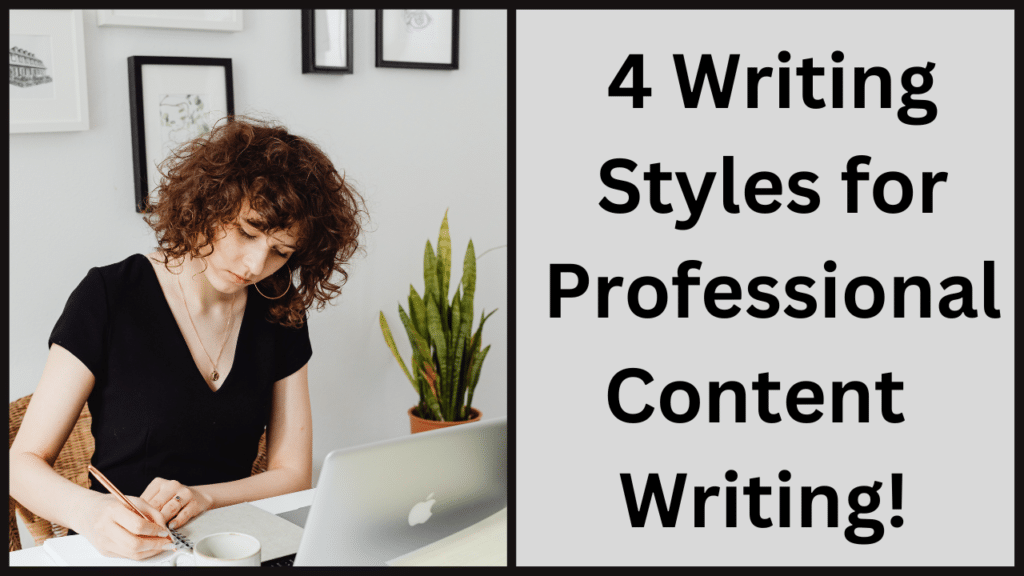Table of Contents
Introduction to Types of Styles in Writing!
Types of Styles in writing is a relatively lesser discussed but often misunderstood topic in content writing. Irrespective of what we do and who we are, we all write and communicate in a certain way. But have you ever considered that there are only four predefined styles of writing English? Each writing style type is suitable for certain specific contexts.
As a writer, knowing the most appropriate writing style for your writing project is essential before you begin crafting your next article, technical report, piece of fiction, or marketing copy. So what are those four writing styles? Let’s have a look:
Now that you know there are four major styles in writing and knowingly or unknowingly, correctly or wrongly, you have been using them for whatever you have written to date. It is time to learn all four styles in writing one by one in greater detail and with compelling and relevant examples. So have a read below:
- Expository
- Descriptive
- Narrative
- Persuasive
Of course, many variations within these larger macro-level writing styles exist; we use specific jargon, have some preferred vocabulary choices, and express a particular tone more than others. All this combines to make our signature writing style unique and reflects our personality. Still, one can bracket all writings in humanity’s history in one of these four styles in writing.
Decoding 4 Types of Styles in Writing:
This article explores all four types styles in writing in considerable detail and explains the suitability and usability of each one with some examples. It also addresses the overlapping areas of these major writing styles.
Whether you are a creative writer, a technical writer, or simply a school or college student still finding your writing groove, knowledge of types of styles in writing can help you become a better writer. So stay attentive and explore each writing style one by one.
What is Expository Style in Writing?
The expository Style is the most commonly used in English writing. Expository writing conveys information about a subject, an issue, a process, or an idea backed by factual and statistical data. It neither gives nor shapes opinions.
In this Style of writing, as the name suggests, the purpose of a writer is to expose or laid bare facts and circumstances as they are. The expository Style is objective and has little to no room for applying subjectivity. There is no room for personal views and dramatic or metaphoric elaboration of the story.
Some well-known use cases for Expository Style in Writing are:
News articles
Technical writing
Medical Research
Scientific Research
Non-Fiction books
Textbooks
Journals
How to guide/process writings
Sequential writings
Comparison and contrast writings
Cause and effect writings
Classification writings
Problem and solution writings
Example 1 of Expository Style in Writing:
The Wikipedia paragraph below explains covid related rescheduling of the Olympics from 2020 to 2021. In this fine piece of expository writing, the author gives factual information without any opinions of any individual or institution. The paragraph in discussion is also an excellent example of cause and effect writing, which is nothing but a type of expository Style in writing.
“Tokyo was selected as the host city during the 125th IOC Session in Buenos Aires, Argentina, on 7 September 2013. Originally scheduled to take place from 24 July to 9 August 2020, the event was postponed to 2021 in March 2020 due to the COVID-19 pandemic, the first such instance in the history of the Olympic Games (previous games had been canceled but not rescheduled). However, the event retains the Tokyo 2020 name for marketing and branding purposes. It is being held largely behind closed doors with no public spectators permitted due to the declaration of a state of emergency. The Summer Paralympics will be held between 24 August and 5 September 2021, 16 days after the completion of the Olympics.”
Example 2 of Expository Style in Writing:
Below are step-by-step instructions on preparing a cup of tea. Notice the instructions about the process without emotions, opinions, or subjectivity in writing.
- Take a saucepan and put it on the gas stove.
- Add a cup of water to the pan and turn on the gas.
- Keep the gas on low flame.
- Add one spoonful of tea powder and leaves to water and some sugar as per taste.
- Boil the mixture.
- After 2- minutes, add some skimmed milk.
- Boil the mixture for another 2 minutes.
- A cup of tea is ready to serve.
What is Narrative Style in writing?
The Narrative Style of writing is essentially story-writing. It may be a real or imaginary story with different characters, settings, conflicts, and often a resolution to the conflict. It should be written in first person when a character is telling their side of the story.
Narrative writing could also use the third person point-of-view when another character shares their perspective of the anecdote. In the latter case, the narrator may not be part of a story. Another important element of narrative writing is its scope of using different types of dialogues, which adds a tinge of realism and interest to the story.
Some Everyday Use Cases of Narrative Style in Writing are:
- Anecdotes
- Short stories
- Fiction novels
- Biographies
- Auto-biographies
- Historical novels
Before we go ahead, I would like to explain the complex concept of Point of view. The POV topic perplexes most writers, irrespective of the writing style. However, it is particularly significant in narrative writing style and, to a large extent, in descriptive writing style, so this is the appropriate junction in this article to elaborate on the concept of POV.
Example -1 of Narrative Style in Writing:
“I landed an internship at my dream company. It was my first day on the job. I was sitting in my window-facing corner seat, overlooking sea waves, and pinching myself to make sure it was not a dream but a reality. I was counting my stars and struggles simultaneously; after all, it’s not every day that your dreams come true.”
Example -2 of Narrative Style in writing:
“My life is not an apology, but a life. It is for itself and not for a spectacle. I much prefer that it should be of a lower strain, so it be genuine and equal, than that it should be glittering and unsteady.”
– Ralph Waldo Emerson
( A noted essay writer of the 19th century)
Three Distinct Points of View in Storytelling:
Writing, mainly narrative and descriptive styles, is essentially storytelling at its core. And when you are telling a story, you must have a perspective or viewpoint to look at characters, situations, and settings.
Every Style of writing uses either of the three points of view. The Point of view is a vision of the storyteller and his story’s perspective. Each POV has its typical usage and advantage in this Style of writing; let us see each one of them with their brief explanation:
First-Person Point of View:
The “I” perspective is at the crux of story narration, and “I” is usually a protagonist or close to the protagonist.
Second-Person Point of View:
Here the story is told from the “You” perspective. This Point of view is not common, but it can create an exciting narrative in some cases or a personalized piece when done effectively.
Third-Person Point of View:
Third Person Point of View has three subtypes. Below each one of them is explained in brief.
Third-Person Limited Narrative:
In this third-person variance, the narrators tell the story from the perspective of one of the characters. They describe every emotion, thought, belief, and action of the chosen character.Third-Person Objective Narrative:
In this third-person variance, the narrator acts as the story’s observer, viewing characters from outside and telling the story from the perspective of one or more characters. He limits his narration to the viewable actions of characters and does not add anything about the character’s thoughts, emotions, and feelings. That’s what objectivity is all about!
Third-Person Omniscient Narrative:
The Narrator act as a know-it-all fellow. The demigods of sorts! He narrates from the perspective of one or more characters and reads and expresses their beliefs, thoughts, and feelings to make the story more multi-dimensional. Nothing in the story can remain hidden from the third-person omniscient narrator.
What is Descriptive Style in Writing?
Descriptive writing is the heart and soul of creative writing. A description can be poetic, dramatic, and usually full of subjective observations. The illustrative (descriptive) writing style gives writers a canvas to paint their observations or imaginations about a scene or character with abundant creativity.
The figurative language is a hallmark of descriptive writing. This Style elaborates on nuances of characters and scene ambiance with generous usage of adjectives, adverbs, metaphors, and other literary devices.
A writer must have good imagination, vocabulary, and knowledge of the different figures of speech to produce an enticing description of the scenes and characters. A scenario described by various writers may have distinct and unique illustrations on the same underlying object, and all could be right. That’s the beauty of descriptive writing.
Some established use cases of descriptive writing are listed below:
- Poetry
- Drama
- Fiction writing
- Writings about Nature
- Science fiction
- Short stories
What makes good Descriptive Writing?
Descriptive writing requires the strategic use of 5 sensory description elements with appropriate usage of Point-of-view (POV) makes Descriptions readable and relatable. In addition, writers must sprinkle descriptive writing with different literary devices.
What is a Fiction Story?
A fiction story consists of imaginary characters interacting with each other in believable situations, which might reflect real-life situations. Conflict of ideas is another essential element of good fiction, and writers must try to resolve it through their stories.
What is Dialogue Writing in English?
Dialogue writing is the art of narrating a story, where characters talk to each other as it happens in actual communication between people. Strategic dialogues add authenticity and interest to the story and draw readers’ attention.
Five Types of Sensory Description with Examples:
1) Visual Description with an example:
It is a way of describing a scene prominently with its visual attributes.
Example – “A beautiful old couple with graceful wrinkles on their faces was having lunch in the rooftop restaurant and looking at each other with childlike affection. It was a sight to behold.”
2) Tactile Description with an example:
It is a method of describing the scenes predominantly using the sense of touch, physical contact, in other words, tangibility.
Example –” The pure pashmina shawls are not only warm but feel soft and tender as if flower petals are caressing the skin.”
3) Olfactory Description with an example:
It is a technique of describing a scene employing adjectives and verbs related to the sense of smell or odor.
Example – “When I ventured towards the unexplored side of the beach, the choking smell of rotten fish spoiled my mood.”
4) Gustatory Description with an example:
It is the art of describing characters’ actions or settings, focusing on the taste and flavors involved in the scene.
Example – “Sam’s bakery in the city center is known for its crunchy dark-chocolate cookies and creamy vanilla cake with mildly nutty cranberry toppings.”
5) Aural Description with an example:
It is the art of describing the scene through its sounds and noise in its environment. It helps to capture the verbal ambiance of the scenes.
Example –” When I heard the booming cloud bust from a distance, I ran inside the room. Soon a gushing gale storm followed, shattering window pans and blasting their way to every corner of our building.”
Persuasive Style in writing:
Persuasive writing is a writing style meant to persuade readers to take action. Its main objective is to influence readers and shape opinions. There is a lot of scope for dramatization, subjectivity, and emotional play here.
This writing style drives the reader towards the writer’s desired objective and often culminates in a well-defined call to action.
The marketing and advertising industry extensively used the Persuasive Style in writing, making it commercially the most viable writing style.
Use cases of Persuasive Writing:
Sales Writing
Brochures Writing
Reviews Writing
Shopping Catalogue Writing
Business Proposals Writing
Political Speeches Writing
Three Elements of Persuasive writing with examples:
Ethos:
It comes into play when a writer uses credibility or authority to persuade their subjects. Example: “I can tell you from my 30 years of experience that this strategy works.”
Pathos:
It comes in use when a writer makes an emotional appeal to their readers to convince them to take the desired action.
Example: “I urge you to fix the sinkhole in our locality; children play nearby, and there could be an accident any day.”Logos:
It comes into action when a writer makes a logical argument backed by statistical data/facts to persuade subjects.Example: “Our record shows that 94 percent of our students got placement within three months of completing this course.”
NOTE: It is prudent to point out that a writer can use one or more types of persuasion together (i.e., Ethos, Pathos, and Logos) to craft a compelling draft based on their judgment, personal preference, situation, and the data.
Conclusion: Understanding Types of Styles in Writing is the foundation of all writings!
Whatever the writing assignment, picking the right style in writing can make or break the project. Subject knowledge, correct grammar, appropriate vocabulary, and readable syntax are all essential elements of good writing. However, the writing style is the foundation of any written work. Your writing’s appeal, effectiveness, and impact all hinge, first and foremost, on picking the suitable writing style. So next time when you sit to draft any writing project, start by choosing the proper writing style and then try to stick to it; this, in my view, is the key to excellent writing!
Video Tutorial on Types of Styles in Writing!

If you liked reading this article, it’s time to take your learning to the next level. Watch my engaging Skillshare class on four styles in writing through this link here. As a bonus, you can watch the entire catalog of Skillshare classes for one month for free. So take advantage and make a move now!
Kartikay Ungrish is the Founder-director of Worthy Education Academy & Worthy Financial Services. He is a UGC NET-qualified Assistant Professor of Management, A MBA, a licenced mutual fund distributor, and a financial advisor. He helps people build wealth through prudent investments in mutual funds and other financial products. Start by creating your free wealth management account with him as your financial advisor. Contact for more details.














